Introduction: From Startup Necessity to Fraud Battlefield
Not many people know this, but we didn’t set out to build a fraud detection company. Like many of the best stories in technology, our journey began with necessity and a near-death experience that would transform our small startup into a global leader in ad fraud prevention.
Our Origin Story
The TV Streaming App That Sparked Innovation
Back in 2010, the world looked very different. The iPad had just launched, streaming was in its infancy, and we were a scrappy team building what we thought would be the next big thing: a TV streaming application. Our vision was simple: bring television content to computers and mobile devices at a time when most people still thought of phones as, well, phones.
We had a great product, passionate users, and one big problem: how do you get people to discover your app in a crowded marketplace?
Why Affiliate Marketing Seemed the Perfect Fit
In those early days, app stores were still figuring out discovery, and paid advertising was expensive for a bootstrapped startup. Affiliate marketing seemed like the perfect solution. We could pay only for results and actual app downloads from real users. It was performance-based, cost-effective, and aligned perfectly with our limited budget.
The 50% Commission Model That Went Awry
We launched our affiliate program with what seemed like generous terms: 50% commission on every paid subscription that came through an affiliate link. Partners loved it. The numbers looked amazing. Downloads were pouring in, and our user base was growing faster than we ever imagined.
For a few months, everything seemed perfect. We were the toast of affiliate marketing conferences, partners were making good money, and we were scaling rapidly. But as we’ve all learned, when something seems too good to be true, it usually is.
The Crisis: How Affiliate Fraud Almost Ended
The Wild West of Affiliate Networks in 2010
The affiliate marketing landscape of 2010 was the digital equivalent of the Wild West. Regulation was minimal, tracking was primitive, and verification systems were almost nonexistent. Networks operated with a “move fast and break things” mentality, and unfortunately, one of the things that broke was trust.
We started noticing strange patterns in our data. Users who downloaded the app never actually used it. Subscription rates were high, but engagement was practically zero. Revenue was flowing in, but retention was abysmal.
Detecting Fraudulent Patterns in Our Logs
Late one night, while digging through server logs trying to understand why our user engagement was so poor, we discovered something that made our blood run cold. Patterns emerged that could only be explained by one thing: fraud.
We were seeing multiple downloads from the same IP addresses, artificial patterns in user behavior, subscriptions that followed inhuman timing patterns, and geographic clusters that defied logical user distribution.
The data painted a clear picture: a significant portion of our “users” weren’t users at all. They were bots, scripts, and fraudulent systems designed to game our affiliate program.
The Financial Nightmare of Chargebacks
The real crisis hit when the chargebacks started flooding in. We discovered that the fraudsters weren’t just gaming our affiliate program with fake clicks and installs. They were using stolen credit cards to make actual purchases through our app.
Here’s how devastating it was: We paid out 50% commissions to fraudulent affiliates, then got hit with chargeback fees from our merchant processor, and had to refund the legitimate cardholders whose cards were stolen. We were losing money three times on every fraudulent transaction.
Our merchant accounts were at risk of being shut down completely. Payment processors don’t tolerate high chargeback rates, and we were approaching the danger zone that would have meant the end of our business.
We would have loved to reach out to fraud detection companies, but in 2010, the solutions were non-existent. We faced a choice: shut down the affiliate program that was supposedly driving our growth, or build something ourselves.
With our survival on the line, we chose to fight.
From Survival to Solution
Late Night Data Forensics
What followed were months of intensive analysis. Our small team became data forensics experts by necessity. We studied every click, every download, every subscription. We learned to recognize the subtle signatures of bot traffic, the telltale signs of click farms, and the patterns that separated legitimate users from fraudulent ones.
We discovered that fraud wasn’t random. It was systematic, sophisticated, and constantly evolving. The fraudsters weren’t just individual bad actors; they were organized operations with resources, technology, and expertise.
Building Our First Fraud Detection Algorithms
Armed with this knowledge, we started building. Our first algorithms were basic but effective. We created rules based on the patterns we’d observed: IP reputation checks, behavioral analysis, timing pattern recognition, and geographic clustering detection.
The results were immediate and dramatic. Our fraud rate dropped from over 50% to manageable levels. User engagement improved. Our actual return on investment became visible for the first time.
The “Aha” Moment
But something bigger was happening. As we refined our system, we realized we weren’t just solving our own problem. We were building something that could help the entire industry. Other companies were facing the same challenges. The fraud we were detecting was part of a much larger ecosystem of bad actors.
That’s when we had our “aha” moment: we weren’t just a streaming app company that happened to fight fraud. We were a fraud detection company that happened to start with a streaming app.
The Evolution of Threats (2010-2025)
Over the past 15 years, we’ve witnessed the fraud landscape transform from simple click farms to sophisticated AI-driven operations. The threats have evolved, but so have we.
Volume-Based Click Farms to AI-Driven Attacks
In 2010, fraud was primarily about volume, generating large numbers of fake clicks or downloads. Today’s fraudsters use machine learning, behavioral mimicry, and distributed networks that can fool even sophisticated detection systems.
Global Fraud Statistics at a Glance
Current global statistics paint a sobering picture: on average 18.31%, nearly one-fifth of digital ad interactions worldwide, may be fraudulent. The scale is staggering with global losses estimated to reach nearly $100 billion annually.
The geographic distribution of fraud reveals interesting patterns. Asia shows 21.89% fraud rates, Europe 19.51%, North America 15.65%, and South America 10.36%. Some countries face extreme challenges, with Georgia (62.89%), Russian Federation (60.7%), and Uzbekistan (60.41%) showing the highest fraud rates globally.
For the latest breakdown of fraud rates by region, see our Global Ad Fraud Statistics by Country.
Even major advertising markets aren’t immune. The United States, with $271.2 billion in digital ad spend, faces a 16.73% fraud rate, while Australia has 18.76% fraud among countries with significant ad spend.
Our Response: Necessity as the Mother of Invention
From our humble beginnings analyzing log files, we’ve built a comprehensive fraud prevention platform that protects thousands of companies worldwide. Our evolution has been driven by the constant arms race between fraudsters and detection systems.
Impact: What We’ve Achieved Over 15 Years
Today, our platform protects some of the world’s largest brands, agencies, and ad networks. From Fortune 500 companies to growing startups, we’ve become the trusted partner for organizations that can’t afford to lose money to fraud.
Over 15 years, we’ve prevented billions of dollars in fraudulent transactions. But more importantly, we’ve helped restore trust in digital advertising. Every dollar we save from fraud is a dollar that can go toward legitimate growth, real customers, and genuine business results.
Looking Ahead: The Next 15 Years of Fraud Prevention
The fraud landscape continues to evolve, and so do we. As we look toward the future, we see several key trends: AI vs. AI battles, privacy-first fraud detection, cross-platform integration, and predictive prevention.
The stakes have never been higher. With global fraud costs expected to continue rising, the need for sophisticated, reliable fraud prevention is more critical than ever.
How Our Biggest Weakness Became Our Greatest Strength
Fifteen years ago, we were victims of fraud. Today, we’re the victors in the fight against it. Our near-death experience taught us that sometimes your biggest weakness can become your greatest strength.
We learned that fraud isn’t just a technical problem but a business imperative. We discovered that the best defense against fraud isn’t just good technology, but deep understanding of the problem, relentless innovation, and the determination to never give up.
Most importantly, we learned that when you’re fighting for your survival, you develop capabilities you never knew you had. The same determination that saved our streaming app has now saved billions of dollars for thousands of companies worldwide.
The war against fraud is far from over. But after 15 years of fighting, we’re confident in our mission: to make digital advertising safer, more trustworthy, and more effective for everyone.
Because when it comes to fraud, we’re not just defending our business. We’re defending the integrity of the entire digital economy. And that’s a fight worth winning.
Ready to join the fight against fraud? Contact us today to learn how our 15 years of experience can protect your business from the ever-evolving landscape of digital fraud.
By Jessica Lopez
 About the Author: Jessica Lopez is Chief Operating Officer and Co-founder at Fraudlogix, a leader in real-time ad fraud detection and prevention. Since co-founding the company in 2010, she has overseen product development, operations, and go-to-market strategy. With over a decade of experience in digital advertising, affiliate marketing, and cybersecurity, she excels at translating complex fraud-fighting technology into actionable insights that help companies protect their digital investments and stay ahead of evolving threats. https://www.linkedin.com/in/jessicalynnlopez/
About the Author: Jessica Lopez is Chief Operating Officer and Co-founder at Fraudlogix, a leader in real-time ad fraud detection and prevention. Since co-founding the company in 2010, she has overseen product development, operations, and go-to-market strategy. With over a decade of experience in digital advertising, affiliate marketing, and cybersecurity, she excels at translating complex fraud-fighting technology into actionable insights that help companies protect their digital investments and stay ahead of evolving threats. https://www.linkedin.com/in/jessicalynnlopez/
References
1. Juniper Research, “Global Ad Fraud Losses to Soar to $170 Billion by 2028,” June 2025. Accessed July 10, 2025.
https://www.emarketer.com/content/which-media-types-most-vulnerable-ad-fraud
2. Fraudlogix, “Ad Fraud by Country,” 2025. Accessed July 10, 2025.
https://www.fraudlogix.com/stats/ad-fraud-by-country



